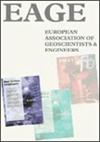结构工程探地雷达测量中的高频广角反射和折射法
IF 1.6
4区 地球科学
Q3 GEOCHEMISTRY & GEOPHYSICS
引用次数: 0
摘要
利用衍射双曲线拟合方法可以估计出探地雷达等偏置数据中的电磁波速度。这种方法适用于当雷达图中包含由小于或等于主波长的散射引起的衍射事件(双曲模式)时。如果没有直接相关的干扰信息,另一种速度估计方法需要收集多偏移量数据。这种方法在广泛的地球物理应用中是很常见的;然而,它似乎没有完全用于工程应用,例如板/墙,其中嵌入特征的厚度估算和深度是结构评估的关键要求。该方法还克服了在无双曲信号特征环境下速度标定的局限性。本研究的目的是探索多偏移高频探地雷达在结构工程中的应用,特别是广角反射和折射方法,以了解其是否可行,可能存在的局限性和优势。模拟钢筋混凝土构件和空腔墙的数值模型进行了分析,以便在实际情况下进行测试之前了解波浪行为并预测响应。主要目的是探讨钢筋如何影响由相似分析得出的速度谱,以及在多层结构中速度随深度增加(空腔壁)的响应。与实际案例的比较表明,尽管存在一些固有的局限性,高频多偏移量方法可以作为所有测量的标准工作流程的一部分,而其他速度估计方法是不可行的。本文章由计算机程序翻译,如有差异,请以英文原文为准。
High-frequency wide-angle reflection and refraction method for structural engineering ground-penetrating radar surveys
Electromagnetic wave velocity in ground-penetrating radar (GPR) constant offset data can be estimated via the diffraction hyperbola fitting method. This method is applicable when radargrams contain diffraction events (hyperbolic patterns) caused by scatters in the host smaller or equal to the dominant wavelength. An alternative method for velocity estimation, if no intrusive information is available for a direct correlation, requires the collection of multi-offset data. The method is quite common for broad geophysical applications; however, it seems not to be fully utilized for engineering applications, such as slabs/walls where thickness estimation and depth of the embedded features are critical requirements for structural assessments. This method would also overcome the limitations in velocity calibration in environments with no hyperbolic signal signatures. The aim of this study is to explore multi-offset high-frequency GPR applications, specifically the wide-angle reflection and refraction method, for structural engineering, to understand whether it is feasible, possible limitations, and advantages. Numerical models reproducing reinforced concrete elements and a cavity wall were analysed to understand the wave behaviour and predict the response prior to testing on real cases. The main purpose is to explore how reinforcing bars can affect the velocity spectra derived from semblance analysis and what the response would be in a case of multi-layered structure with increasing velocity with depth (cavity wall). The comparison with real cases showed that, despite some intrinsic limitations, high-frequency multi-offset approach could be part of standard workflow for all those surveys where no other velocity estimation method is feasible.
求助全文
通过发布文献求助,成功后即可免费获取论文全文。
去求助
来源期刊

Near Surface Geophysics
地学-地球化学与地球物理
CiteScore
3.60
自引率
12.50%
发文量
42
审稿时长
6-12 weeks
期刊介绍:
Near Surface Geophysics is an international journal for the publication of research and development in geophysics applied to near surface. It places emphasis on geological, hydrogeological, geotechnical, environmental, engineering, mining, archaeological, agricultural and other applications of geophysics as well as physical soil and rock properties. Geophysical and geoscientific case histories with innovative use of geophysical techniques are welcome, which may include improvements on instrumentation, measurements, data acquisition and processing, modelling, inversion, interpretation, project management and multidisciplinary use. The papers should also be understandable to those who use geophysical data but are not necessarily geophysicists.
 求助内容:
求助内容: 应助结果提醒方式:
应助结果提醒方式:


